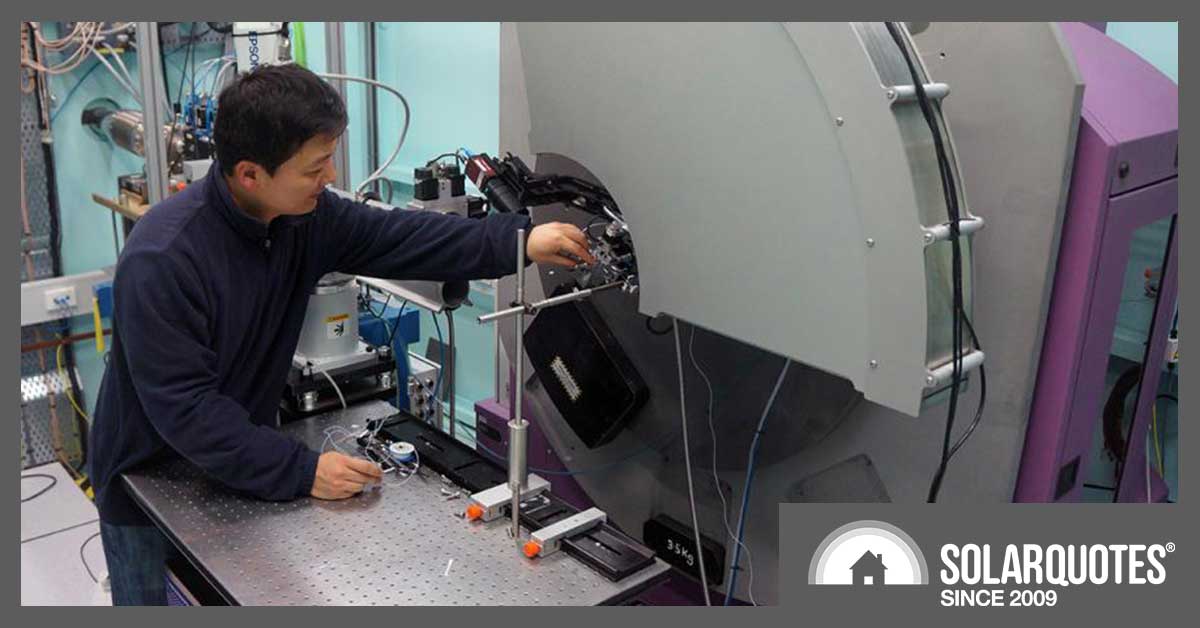
Dr Qinfen Gu in action with the Powder diffraction beamline
Flow batteries have long been seen as the poor cousin to the ubiquitous lithium-ion battery, trailing in energy density and charge/discharge rates.
However, they have well-documented advantages – many flow battery chemistries are non-toxic and non-flammable, and they can undergo many more charge/discharge cycles than lithium batteries.
The iron flow battery uses iron chloride as its electrolyte, and a group of researchers from the University of Queensland is working with the Australian Nuclear Science and Technology Organisation to build a better iron flow battery.
ANSTO explains what University of Queensland researcher Dr Bin Luo wants to develop here.
The iron flow process discharges by changing the oxidation state of iron chloride.
When the battery discharges, the iron-chloride solution (FeCl2) is pumped to the positive electrode, which reacts with oxygen from the air to form ferric chloride (FeCl3). This reaction releases electrons as electricity.
Charging reverses that process: the ferric chloride solution is pumped to the negative electrode, where it reacts with electrons from the external circuit to form iron chloride again.
However, ANSTO explained:
“There is a low round-trip energy efficiency caused by a competitive side reaction that occurs at the negative electrode during battery charging.”
Dr Luo of UQ’s Australian Institute for Bioengineering and Nanotechnology, Professor Ian Gentile of the university’s School of Chemistry and Molecular Biosciences, and research fellow Dr Masud Rana hope to use the synchrotron’s powder diffraction beamline to find a way to eliminate that side reaction1.
Principal beamline scientist Dr Qinfen Gu will support them.
“The powder diffraction beamline is useful in determining how structural modifications impact function. The performance of innovative new materials can also be tested on an operating battery at the Australian Synchrotron, where we support a great range of battery research,” said Dr Gu.
Their work, supported by $461,000 in ARC Linkage funding, will work on engineering the interface between the negative electrode and the electrolyte, to improve battery performance and reduce costs.
ANSTO’s announcement explained:
“The goals of the project are to design iron electrodes with functional interface layers; demonstrate the iron flow battery technology at the lab scale; undertake a pilot scale test of the technology for commercial applications; and understand the effect of the functional interface layer on the iron plating process and battery performance.”
“We expect that this project will result in new materials and methods for advanced battery technology, while also supporting the national priority of net-zero carbon emissions by 2050,” Dr Luo said in a University of Queensland media release.
The researchers are being partnered by Energy Storage Industries Asia Pacific, which is building a $70 million facility in Maryborough to manufacture the batteries.
ESI claims the iron flow chemistry offers up to 14 hours of energy storage and a 25-year lifespan; upwards of 20,000 cycles without degradation; and the chemistry is non-toxic, non-flammable and fully recyclable.
Since it’s based on iron, the source material is cheap and easy to mine.
Footnotes
- A synchrotron’s powder diffraction beamline is a facility that uses synchrotron radiation to study the crystallographic structure of materials. ↩

 RSS - Posts
RSS - Posts



Speak Your Mind